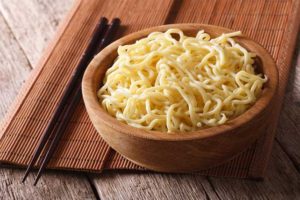
Through a notification dated 20 July, 2016 the FSSAI has proposed to make amendments to the standards in the Food Safety and Standards (Food Products Standards and Food Additives) Regulations, 2011, in the category related to ‘Cereals and Cereal Products.’ The proposed amendments are for products like fortified atta, fortified maida, Durum wheat maida, quinoa, fortified rice, instant noodles, tapioca sago or palm sago and Pearl millet flour. The FSSAI has also invited comments and suggestions from WTO and SPS Committee members within a period of 60 days from the above mentioned date.
Fortified Atta, Fortified Maida and Fortified Rice have been defined as products in which the following nutrients can be added
- Calcium,
- Iron
- Zinc,
- Vitamin A and
- Ascorbic Acid (Vitamin C),
- Thiamine (vitamin B1)
- Riboflavin (vitamin B2)
- Niacin,
- Pyridoxine (vitamin B6)
- Folic acid,
- B-12
- Vitamin D
The FSSAI has proposed different levels of fortifications for these nutrients which will be in milligrams per kilogram of atta, maida or rice. The standards of atta, maida and rice will be the same as already prescribed in the regulations.
Durum Wheat Maida
Since there were no standards for Durum Wheat Maida earlier, the FSSAI proposes to add standards for the new product in the category ‘Maida’ Since this is a new product it will be defined as a product prepared from grains of durum wheat (Triticum durum Desf.) by grinding or milling processes in which the bran and germ are essentially removed and the remainder is comminuted to a suitable degree of fineness. Standards proposed will be as follows
| Moisture | Not more than 13.0 per cent |
| Total Ash | Not more than 1.75 per cent on dry basis |
| Acid insoluble ash in dilute HCL | Not more than 0.15 per cent on dry basis |
| Protein | Not less than 11.0 percent on dry basis |
| Alcoholic Acidity | Not more than 0.12 per cent |
| Particle Size | Min 80% shall pass through a 315 micron silk gauze or man-made textile sieve |
Quinoa
FSSAI has proposes another change in the sub- regulation dealing with the category related to “Food Grains” where it proposes to add a new product called Quinoa. This product consists of dried matured grains obtained from the plants of Chenopodium
quinoa from which Saponins have been removed by washing, scouring, dehulling or
by any other suitable process. Proposed standards are as follows
| Moisture | Not more than 12.0 per cent |
| Extraneous Matter | Not more than 1 percent by weight |
| Other edible grains | Not more than 0.5 per cent |
| Damaged grain | Not more than 3.0 per cent |
| Uric acid | Not more than 100 mg/kg |
| Saponin Content | Not more than 0.1 per cent) |
Instant Noodles
In the sub-regulation dealing with “Macaroni Products” the FSSAI proposes to now add standards for Instant Noodles. According to the definition Instant noodles does not include the seasoning. It can be prepared from cereals like wheat flour and/or rice flour and/or flour of any other cereals, millets and legumes covered under “Cereals and Cereal products” and water as the main ingredient. It can have additives like starches, dried fruits and vegetables, nuts, edible protein and egg Powder may be added. It is characterized by the use of pregelatinization process and dehydration either by frying in any oil or fat prescribed in the regulations. The product should be presented as Fried noodles or Non-fried noodles. Standards proposed are as follows
| Fried Noodles | Non-fried Noodles | |
| Moisture | Not more than 10.0 per
cent |
Not more than 13.0 per
cent. |
| Acid insoluble ash
(on dry basis ) |
Not more than 0.3 per
cent |
Not more than 0.3 per
cent |
| Acid Value | Not more than 2.0 | — |
Tapioca Sago or Palm Sago
In sub-regulation relating to “STARCHY FOODS” the FSSAI has proposed that the name SAGO be replaced with Tapioca Sago or Palm Sago. This is a product made from the starch obtained either from Sago Palm (Metroxylon sagu and M.rumphii) or tubers of tapioca (Manihot esculenta crantz syn. Utilissima) and will be free from all kinds of adulterants including bleaching, whitening agents or optical whiteners, sweetening agents or any other adulterant.
Standards proposed will be as follows
| Moisture | Not more than 11.0 per cent |
| Total Ash (on dry basis) | Not more than 0.40 per cent |
| Acid insoluble ash (on dry basis) | Not more than 0.10 per cent |
| Starch (on dry basis) | Not less than 98.0 per cent |
| Protein (on dry basis) | Not more than 0.3 per cent |
| Crude fibre (on dry basis) | Not more than 0.20 per cent |
| pH of aqueous extract | 4.5 to 7.0 |
| Colour of gelatinized alkaline paste in the porcelain cuvette on the lovibond scale not deeper than
|
0.4R+1.5Y |
| Sulphur Dioxide content | Not more than 100 ppm |
Pearl Millet Flour
In the category of bakery products under ‘Cereals and Cereal Products’ new product is proposed to be included by FSSAI called Pearl Millet Flour. Definition for Pearl Millet flour is that it will be a product obtained from pearl millet grains (Pennisetum americanum L.) through a process of milling. Prosed standards for this is as follows
| Moisture | Not more than 13.0 per cent |
| Total Ash | 0.8 to 1.0 per cent on dry basis |
| Protein (N×5.7) | Not less than 8.0 per cent on dry basis |
| Fat | Not more than 6.0 per cent |
| Crude Fibre | Not more than 1.5 per cent on dry basis |
| Particle Size | Shall pass through 1mm sieve |
Leave a Reply